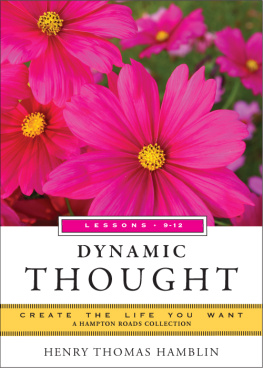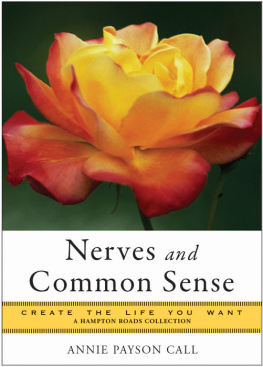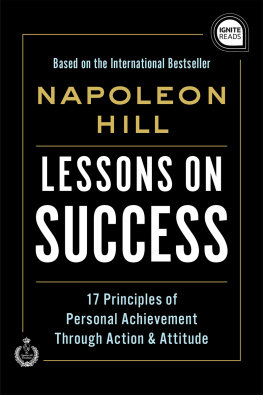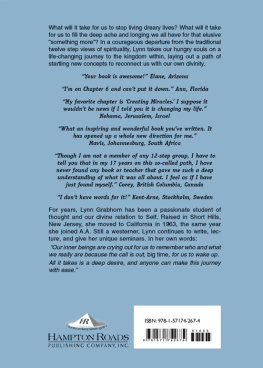DYNAMIC THOUGHT, Lessons 912
Harmony, Health, Success, Achievement, Self-Mastery, Optimism, Prosperity, Peace of Mind, Through the Power of Right Thinking
The Third Four Lessons of Success and Character Building
Henry Thomas Hamblin
Mina Parker
Create the Life You Want
A Hampton Roads Collection
This ebook edition first published in 2012 by Hampton Roads Publishing Company, Inc.
With offices at:
Charlottesville, VA 22906
www.redwheelweiser.com
Copyright 2012 by Hampton Roads Publishing Company, Inc. All rights reserved.
Excerpted from Dynamic Thought by Henry Thomas Hamblin, 1921 & 1923.
eISBN: 978-1-61940-106-8
Cover design by Jim Warner
Contents
Introduction
I always loved the first day of a new school year: the fresh pencil erasers, notebooks with sheet after sheet of blank paper, the possibility and purpose and preparedness of it all. Even as I got older, poring over course descriptions in the college catalog was a favorite pastime. You could practically feel your brain expanding with the exposure to new ideas, with the anticipation of challenging goals being set and met.
So, trolling through the works of early New Thought author Henry Thomas Hamblin, I was delighted to find just such a course description:
THE objects of this course are: (1) To alter your mental attitude, and (2) To direct your thoughts into those channels which lead to success, achievement, health, happiness and perfect good; (3) The arousing of the inward POWER, and (4) The overcoming of bad habits; (5) The building up of character, and (6) The discovery and development of the creative faculty.
Oh joy! I am a true nerd. But you don't have to love school to get into these lessonsinner power, strong character, creativity. These aren't school lessons, they're life lessons, and even though this textbook is almost a hundred years old (and has its delicious old-time quirks) it feels fresh, a reminder of how timeless the basics of meditation and thought-creation are.
I could feel the mental shopping trip begin for my twelve-week course. I would need imagination, affirmations, heightened consciousness, hope, determination, cheerfulness, and a few quiet moments to set aside each day. I decided to take it a month at a time, to have time to stop and evaluate before moving on. In this volume, I'm including part nine through twelve on their own. Wrapping up three months of investigation, practice, and progress.
The greatest gift of these lessons is Hamblin himself, like that teacher you will always remember whose voice comes into your head at just the right moment, saying just the right thing. His relentless positivity and passion shine through again and again, with this essential reminder: to go forward with joyyou can never fail.
MINA PARKER
Henry Thomas Hamblin was a New Thought writer, a mystic, and the founder of The Science of Thought Review (a magazine still published today under the name New Vision). Born into a poor family, Hamblin worked hard to become a successful businessman. His success, however, never caused him happiness, and he waged a constant inner battle between his businessman self and his mystic self. After years of depression followed by the tragic death of his son, Hamblin left behind the world of business to find answers from his visionary experiences with a Divine Presence. Hamblin's work continues today through the Hamblin Trust.
Introduction
THINGS TO OBSERVE
Do not worry because you cannot follow the course exactly to the letter. Do what you can of it, adapt it to your life, and do the best you can in present circumstances.
The principal thing is to get twice daily into what is called the Silence, to quieten the senses, and get in touch with the Unseen, i.e., God, Divine Mind, the Infinite, Principle of Good, First Cause, the Absolute, the name does not matter, they all mean the same.
Another vital thing is to use affirmations and denials, these will be explained more fully later.
Yet another is meditation, for you gradually grow into the likeness of that upon which you meditate.
Still another is visualizing. Always visualize the good, the beautiful, and true, and your life will reflect these things. Incidentally, the practice of visualization greatly increases one's powers of concentration.
Also while you are receiving this course and for some time after, refrain from all hazardous speculation. Do not launch out in business without sufficient capital and then expect everything to turn out all right. Instead wait until the way is made clear. Guidance and help will come in time, therefore do not try to force things.
Remember that although as soon as you start right thinking, you begin to build up your life, yet it takes time to manifest. At first things may seem to be worse, if so keep on and they will soon settle down. You cannot fail in the long run if you will persist and persevere.
I want you to realize:
That within you are infinite power and possibilities.
That the inward Power can be aroused and brought into expression by holding high ideals in the mind and by affirmations and meditation.
That it is necessary to spend a short time in the Unseen both night and morning.
That by so doing you can enter a super-conscious realm where your word is creative.
That what you speak comes to pass, that what you mentally picture must come true.
That it is only by following high ideals that true success can be achieved.
Therefore, picture a higher life--the highest you can conceive, and affirm that it is yours. Remember that this higher life is without sickness, disease, forward with joy--you can never fail.
Success and Character Building
PART IX
MANKIND is divided into two types, positive and negative. Let me try and describe each to you.
Positive man is magnetic, attractive, courageous, happy, cheerful, healthy, energetic, is full of vitality, power and ability to succeed. He never doubts his ability to win, he never worries when things go wrong; he does not complain when things are not smooth. If he meets with a temporary set-back he becomes the more determined to succeed. He does not lay upon other people the blame of his own mistakes, but instead learns a lesson from his temporary failure which shall be a guide and beacon in all future undertakings. The positive man can always find people to believe in him and to finance his operations. He never lacks friends, for just the type of people he wants are always anxious to be his friends. Consequently men, and with them, opportunities, are always coming his way. He is an optimist, but is not foolish or blind in his optimism. He is above being petty or mean, or selfish or cruel; neither does he let hate or anger sway him or influence his life or business. He inspires confidence, compels attention, is a leader rather than a follower, and literally exudes an atmosphere of success.
A negative man is, of course, the antithesis of this type. He is fearful, given to worry, apt to look on the dark side of things. Is afraid to act too much on his own responsibility and seeks the help and advice of other people. Has difficulty in making up his mind, and when he has made it up he often changes it. He lets others pass him in the race of life and then worries because he fails to get on. He is never much of a success in life, no matter what he achieves he might have done very much better. He seldom realizes that his failures are due to his own failings but, instead, lays the blame upon other people's shoulders or ascribes his troubles to chance or ill fortune. His company is not cheerful and is not sought by other people, except one or two as miserable as himself.
Next page












![Lynn Grabhorn - Excuse Me, Your Life Is Waiting: The Astonishing Power of Feelings [study edition]](/uploads/posts/book/80188/thumbs/lynn-grabhorn-excuse-me-your-life-is-waiting.jpg)